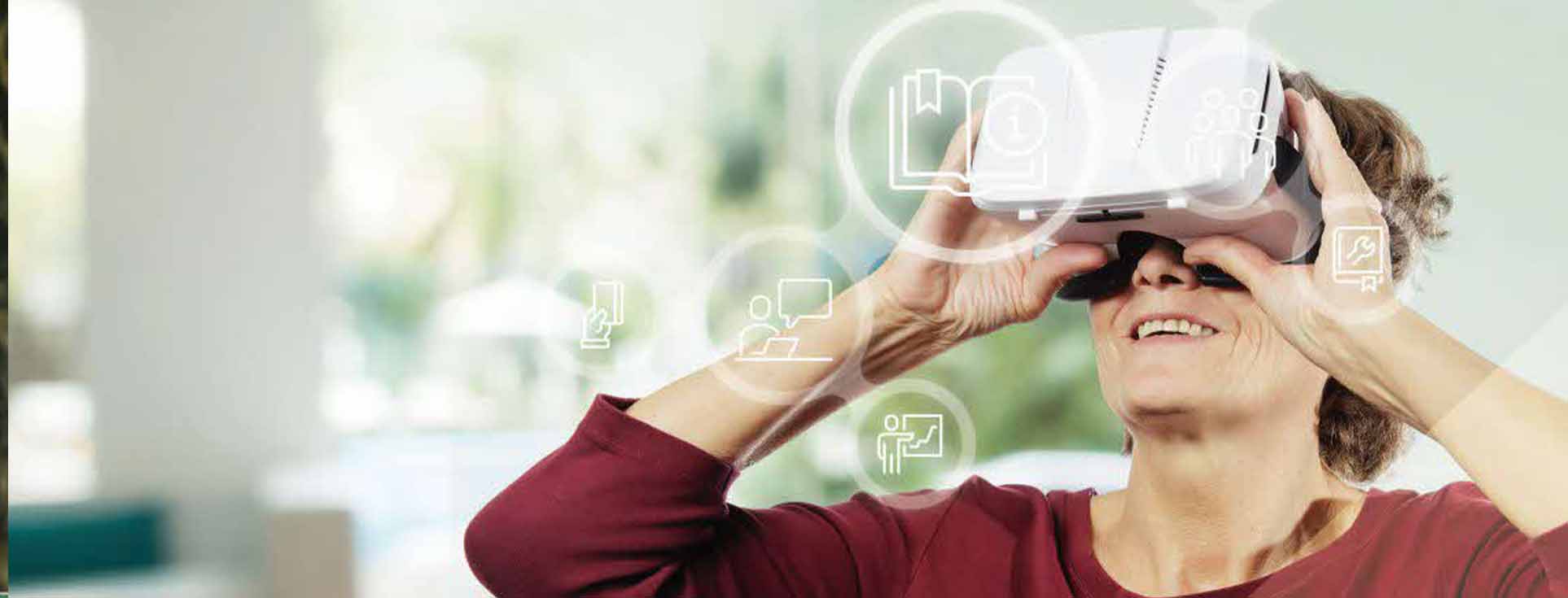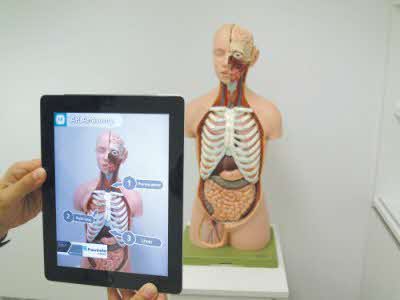Promoting Active Ageing through Virtual & Augmented Reality
ETHOS Issue 20, Jan 2019

Human beings have long desired to live longer, and now our advances have made this dream possible. However, greater life expectancy comes with a price. As the elderly population in our societies rise, we are seeing attendant challenges such as social isolation, loneliness, and increased depression rates among the elderly. Social counsellors have identified several reasons for this trend, including a lost sense of purpose in life, a lack of confidence in dealing with their own decline, and the refusal to be a burden to others.1 Almost a third of the elderly have reported experiencing loneliness.
Perhaps more important than how long we live, is how well we live. Research has shown that in order to age in an active and healthy way, both physically and mentally, we must continue to do a certain level of work, even after retirement. The right amount of work will vary for each individual. We cannot help but face changes in our physical and cognitive abilities as we get old, which means that we may not be able to continue with the same kind of work that we might have been doing when younger. As we age, learning new skills gets more difficult as well, which tends to impede our willingness and ability to participate in learning.2 An important question is how to support the elderly, and society in general, in developing the appropriate capacities to flourish in an ageing society.
More important than how long we live, is how well we live.
Singapore has recognised both opportunities and challenges in these demographic changes. The government has sought to make economically and socially sustainable adjustments to the family, workplace and community, so as to ensure a fulfilling and dignified life for everyone—including those in their senior years.3 In pursuing our vision of becoming a Smart Nation, Prime Minister Lee Hsien Loong has promised that the elderly and the less-technology savvy would not be left behind.4 Several initiatives involving innovative uses of technology have been rolled out to help the elderly age in place, such as smart sensors and remote monitoring software at home.5
PASSIVE-USER VERSUS ACTIVE-USER APPROACHES TO TECHNOLOGY FOR SENIORS
While such elderly-friendly technologies are designed with good intentions in mind, they may be limited in their ability to allow the elderly to truly live independently. Many current innovations targeted at the elderly are designed to help those who are weak and frail, or who require constant monitoring. But this stereotypical image of the elderly is hardly an accurate description of every senior in society, especially when research has shown that many seniors can and want to lead an active life with dignity and autonomy.6,7 As such, this current passive-user approach for the ageing population may result in resentment among the elderly and lead to rejection of use, as suggested by recent reports in Singapore.8 Instead, an active-user approach—where technology is used to empower the elderly to live independently—would be more aligned with active ageing. However, this vision is far from the current reality.
For instance, social workers in Singapore reveal that many of the elderly currently depend on them to assist with daily tasks such as using the ATM machine to withdraw money, using automated self-service kiosks to top-up EZ-link cards or pay bills, or dialling an automated hotline to make enquiries. Apparently, elderly people are having problems adjusting to our increasingly automated society. As such, there is a pressing need to provide adequate training for the elderly, to enable them to carry out essential functions and handle various aspects of life independently and confidently.
An active-user approach—where technology is used to empower the elderly to live independently—would be more aligned with active ageing.
HELPING SINGAPOREAN SENIORS TO LEARN BETTER
Conventional training and teaching methods used for the elderly in one-to-one settings are not cost-effective. They also do not take into account Singapore’s unique context, in which the elderly have varying levels of language and technology literacy. Successful lifelong education for the elderly requires a deeper understanding of how seniors learn, and careful, deliberate planning to support their learning.9
In light of these concerns, an interdisciplinary research team at Nanyang Technological University, Singapore proposed to use virtual reality (VR) and augmented reality (AR) tools to help build up the confidence of the elderly and empower them with relevant skills. VR immerses the user in an alternate virtual environment, while augmented reality (AR) overlays digital information onto the real environment around us. The project, led by this author and funded by SkillsFuture Singapore, aims to provide a cost-effective VR and AR learning system for elderly Singaporeans through the creation of virtual and augmented reality self-support training programmes (VRSTPs). These are individual training environments that can be tailored to the different learning curves and needs of individual seniors. They can help to familiarise the elderly with situations such as an ATM interface or work environments, providing a simulated experience closer to that of actually using the machine, or being at the workplace. VRSTPs also offer the ability to learn at one’s own pace, which would likely reduce the peer pressure of keeping up with others, or the anxiety of holding others back, minimising unnecessary stress.
Although the project has just begun, its findings will be timely and relevant given Singapore’s current societal developments and policy directions, in light of a broader global trend of exploring new applications for VR and AR technology.
 |
 |
Examples of educational applications and ATM interface developed by Fraunhofer Singapore (co-Principal Investigator of the project)
VR and AR: The Next Frontier in Technology
VR is set to become a significant computing platform within the next decade, with applications in a wide variety of sectors, from retail to education and healthcare. The launch of consumer gadgets such as Samsung Gear and the Google Cardboard means that VR technology is becoming increasingly affordable and accessible. This is a good time to capitalise on the technology to design interventions that can address broader societal concerns.
VR/AR interactive technology offers many advantages to the field of elderly training:
- The systematic delivery and control of digital parameters, such as difficulty levels or task requirements. This means that challenges in interactive learning scenarios can vary according to individual needs, including educational level, language ability and familiarity with technology.
- Realistic environments can be simulated for interactive scenarios, incorporating challenges that require real world social and practical skills. These mean that training outcomes can be readily applied to the real world.
- A wealth of high quality interactive data can be collected. This may include the time taken to complete a task, or other behavioural information. This data can be used to assess and review the training process for each person, and for machine learning to improve future development and design.
- Game features can be added to serious tasks. Features such as real-time visual, auditory and haptic feedback can motivate elderly users, and can also help them feel more immersed in the virtual interaction scenarios.
TIMELY INTERVENTIONS TO ADDRESS SOCIAL CHANGES
We need to help seniors transition to more technology-oriented Singapore. If we want to promote active ageing and independent living among seniors while realising our Smart Nation vision, we must provide adequate and appropriate support for seniors to adjust. Recent studies suggest that many of the neediest in society—over 65% of the elderly who receive ComCare long-term assistance—live on their own.10,11 This presents concerns because beyond financial needs, many elderly people can be stumped by essential everyday tasks, and often have to approach others for help. This can put a strain on social workers, who already have their hands full.
Using VRSTPs to teach the elderly how to handle some of these tasks on their own could improve their sense of autonomy, improving their psychological well-being, while reducing the need for assistance. Simulated job training provided by VRSTPs could also help the elderly overcome psychological barriers to learning new skills, and enable them to find some meaningful employment, which will have benefits for their well-being, self-esteem, and sense of relevance in a Smart Nation. It would also alleviate the current increasing demand on social welfare, offering a more sustainable form of support in the long run.
By providing tangible evidence on the effectiveness of interactive technology in promoting active ageing, our findings could help policymakers, social workers and non-profit organisations develop better training programmes for the elderly in terms of daily tasks, job training, and the acquisition of technological literacy. This will be vital to Singapore’s attempts to address the challenges and opportunities brought about by an ageing population in a cost-effective way.

